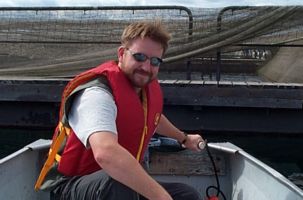AQUACULTURE STUDENT

GREGOR REID
What They Did Back Then
* Bachelor of Science, Marine Biology completed 1993,
University of Guelph
* Master of Science in Aquaculture completed 1996,
University of Guelph
* Doctor of Philosophy completed 2004, University of
Guelph
Advisor: Professor Richard D. Moccia
Evaluation of nutrient loading dynamics from tank and cage cultured rainbow trout.
ABSTRACT
Most of Ontario's aquaculture production is from rainbow trout cage culture in Lake Huron. In this environment, it is difficult to distinguish farm-loaded nutrients from other sources. Extensive near-field (<30m distant) spatial and temporal variation of nutrient concentrations can also affect the accuracy of discrete samples to infer mean conditions. An improved understanding of nutrient loading dynamics and measurement models is required to effectively manage and regulate these farms. To address these issues, diel (24 hour) fluctuations of soluble effluent from tank culture rainbow trout (Oncorhynchus mykiss), near-field nutrient loading dynamics at a cage-site in Lake Huron, and a model to estimate cage-site outflow of phosphorous concentrations were investigated.
Diel effluent concentrations of soluble phosphorus (SP), total ammonia nitrogen (TAN) and dissolved oxygen (DO) from rainbow trout tank water varied in a non-liner (p<0.05) pattern. The coefficient of variation for diel SP concentrations in tank water was 16% at 8° C and 23% at 15°C.
At the commercial field site, mean water quality and current dynamics from 6 multi-day periods were measured. Near-field, period mean concentrations of total phosphorus (TP) ranged from 4.5 + 0.9 to 11.7 + 6.7 µg L-1. The distribution of these concentrations was non-normal with standard deviation increasing with the means. Variation of TP, pH and DO increased with exposure to the source of nutrient loading, from the inflow, outflow to the site center. These water quality parameters also varied together, the strength of their correlations also increasing with exposure.
Where They Are Now
Dr. Reid is currently undertaking a joint Post Doctoral Fellowship with the University of New Brunswick and the Department of Fisheries and Oceans, Canada. Presently, his work involves the development of a general flexible model for integrated multi-trophic aquaculture systems; incorporating his past experience of nutritional ecology, Monte Carlo simulation, eco-exergy, bioenergetics and mass-balance modeling.
Over the years Dr. Reid has become a very accomplished researcher. For example, he developed methods using instantaneous relationships of pH and dissolved oxygen to differentiate near-field phosphorus loaded from fish cages. He modelled near-field "nutrient plume" concentrations from rainbow trout cages. That gained knowledge helped with his work to develop a decision support tool for the licensing of freshwater cage aquaculture in Ontario.
More recently, Dr. Reid has been working to determine the quantity and quality of nutrient inputs for co-cultured species in Integrated Multi-Trophic Aquaculture systems through the application of Monte Carlo simulations to mass balance salmonid waste models; accounting for variation in proximate composition (diet) and digestibilities.
Other Publications:
Reid GK, Liutkus MJ, Robinson S, Chopin T, Blair T, Lander T, Mullen J, Page F, and Moccia R. 2008. A review of the biophysical properties of salmonid feces: Implications for dispersal models and co-cultured species at sea cages. Aqua. Res.39 (12).
Reid GK, Robinson SMC, Chopin T, Mullen J, Lander T, Sawhney M, MacDonald B, Haya K, Burridge L, Page F, Ridler N, Boyne-Travis S, Sewuster J, Szemerda M, Powell F, and Marvin R. ( in press). Recent Developments and Challenges for Open-Water, Integrated Multi-trophic Aquaculture (IMTA) in the Bay of Fundy, Canada. Aquaculture Canada 2007, Proceedings of Contributed Papers.
Reid, G.K., and Moccia, R.D. 2007. Estimating aquatic phosphorus concentrations 30 metres down-current from a rainbow trout cage array. J.Environ. Monit. (Accepted)
Reid GK. 2007. Chapter One: Nutrient Releases from Salmon Aquaculture. In: Costa-Pearce B. (Ed.), Nutrient Impacts of Farmed Atlantic Salmon (Salmo Salar) on Pelagic Ecosystems and Implications for Carrying Capacity. World Wildlife Fund (Accepted)
Moccia RD and Reid GK. 2007. Aquaculture
Sustainability: Issues and Concepts of a Decision Support
Tool for the Licensing of Fish-Cages. Aquaculture Canada
2006, Proceedings of Contributed Papers. AAC Special
Publication, No. 12
Reid GK, Moccia RD and McMillan I. 2006. Near-field
loading dynamics of phosphorus and short-term water
quality variations at a rainbow trout cage farm in Lake
Huron. J. Environ. Monit. 8: 947-954
Reid GK and Moccia RD. 2006. Diel fluctuation of soluble phosphorus in the tank water of rainbow trout, Oncorhynchus mykiss (Walbaum), and relationships with feed inputs and dissolved oxygen. Aquaculture Res. 37(15): 1606–1610
Calibration of YSI multiprobes used in study

Working on some modelling at the WWF Salmon Dialogue Nutrient Working Group meeting in Rhode Island.
